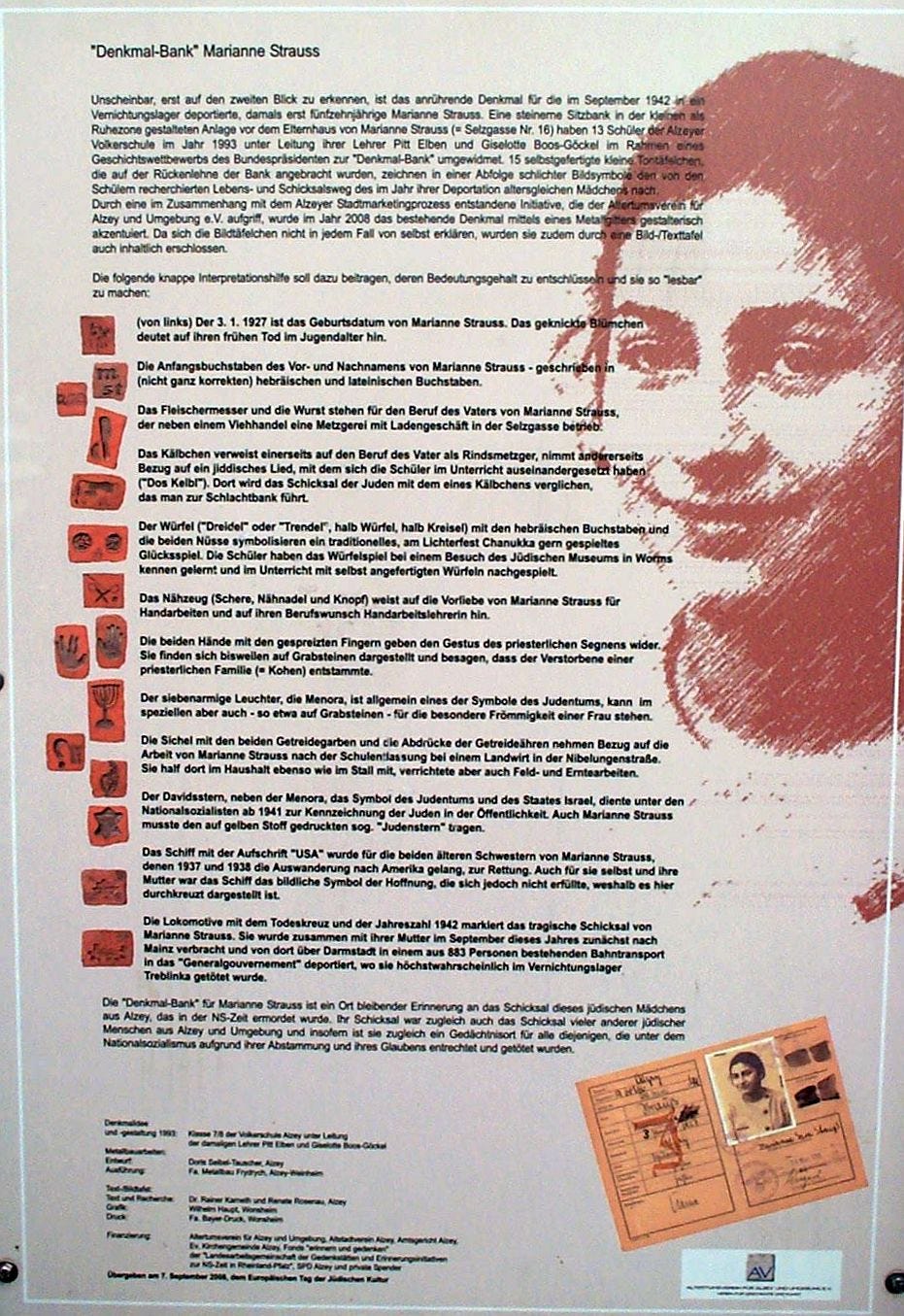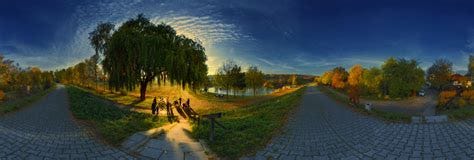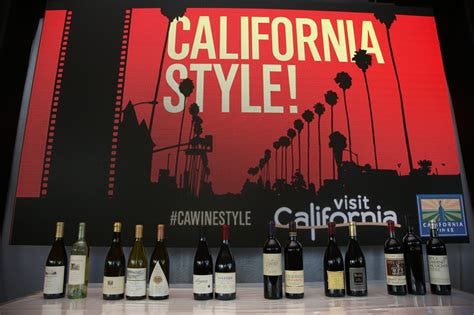Alzey pronounced "owl's eye"
Celtic fort, Roman redoubt, Nibelungen minstrel, Rheinland vineyard, Shoah shutdown, Allied missed target: one town's microcosm of many cross'd-roads
What one market town, perched on Germany’s western rim, may tell us, long battled for by Burgundians, Lotharingians, Franks, Hessians, Prussians, Bavarians, Napoleon. Not to mention the Reich, occupied after by French. Always a bucolic wine-making hub, where the timbered burg itself owns part of a Rhenish sweet white’s cultivation.
My favorite mineral water by far’s brisk Gerolsteiner (man I miss it in El Sur, although tangy Güitig’s not a bad substitute from these Andes) filtered through Eifel’s calcified volcanic soil beneath the loess—Alzey’s a few miles from the Rhine, on a tributary, fittingly the Salz—enriching the grapes which give this forested realm distinctive flavors in both libations. While I’m too much of a lightweight (what my wife always dubbed herself as a “cheap date”) and too light in the pocketbook to indulge my nascent oenophile, my stepfather’s father certainly was one of the leading advocates. And, that’s a story that will appear soon in these entries. You have him to partly thank for that early-70s contest where a California red bested France’s boastful bounty, and him to credit for my state’s Wine Institute, and for two of the first mass-market books to popularize American vintages in that decade. Ever since Prohibition was repealed in the woozy depths of the Depression, he vowed to rescue its reputation from Mafia bootleggers; to transform, no miracles needed for this S.F. son of a Russian emigrant escaping pogroms, non-jug table wine “safe” for try-curious ATF-law-abidin’ citizenry.
But I digress. I’ve always been intrigued by how wine and beer, liqueurs and bottling, reflect cultures, and I’ve long insisted (to myself) drinking monastic Trappist brews (of their cousins the Benedictines or Chartreuse from the Carthusians) should, speaking of the 1930s on, as to changing consumption, get a tax credit for charitable donations. Here’s my Münich-born, Sudeten German-English, from dissenters jailed and worse by the Gestapo, friend Michael, in a contribution to marketing of this domain. His cover design from one of the many he does, in-house graphic artist at Angelico Press. We’ve shared more than one if not stein than dark-roasted tall glass in long fellowship.
As to Alzey, no need to recapitulate Wikipedia, given again most relevant information eludes me in Deutsch. The 400 BCE fortress of my ethnolinguistic (not “racial”!) kin succeeded settlers going back to Neolithic times, and preceded the Roman Empire setting up a 227 CE base named after the “displaced” Celts, Altiaia. Topped by an appealingly (or appallingly once the hirsute and flea-bitten locals dunked Christers a couple of centuries on) Nymphenstein, “nymph’s stone.” No idea, alas, what the name signifies, but the legion’s “Vicani Altiaienses” (“villagers”) took that as its own signal camp on the “limes” or frontier near the great barrier of the mighty river that long separated the civilized from the barbarians on its other bank. Then the imperial realm contracted, trousered mercenaries contracted among the neighbors turned tail or coat.
Burgundians rushed in, and in the chaos of a generation ca. 500, the core of legendary cycle the Nibelungenlied, embellished this pre-Carolingian tale. I’ve tackled Burton Raffel’s translation. (I like his version of Don Quijote, and took it with me to Ecuador.) But loyal reader, it was boring. Volker’s barely there early on, then gone. A dull hack-a-thon, if the same muddy trudge that ended Python’s filmed Grail quest prematurely. Volker’s "a minstrel and player of the fidla, a medieval stringed instrument among the predecessors of the violin." You can find out the verses which laud him via Wikipedia.
Volker von Alzey (right) in combat against a Bernese monk, Islan, from the Rosengarten zu Worms. Off 2/3 a millennium; Islan dresses like a Dominican friar (founded 1209), but it’s a sharp (insert Monty Python joke) depiction, innit? Nudge?
What’s next? The usual. Huns, Holy Roman Empire, Thirty Years’ and Nine Years’ wars (the town is about 2/3 Lutheran), Palatinate, a certain small-statured Corsican. He established a “Cisrhenian” (love that title, “over the Rhine”) republic; a feat that repeated in the aftermath of the Great War, restive over a second occupation by the French. These Rhenish, which this your Irish scribe appends, may number among stranded Eurominorities, “stateless” nations, e.g. Catalunya, Cymru, Corsicans too.
Hard to discern any Rhenish flag or domain, if on a crowded Eurominority map. If you’re geographically challenged, both hit their respective display’s bull’s eye. Which never bodes well for anywhere so placed, unless you’re a arms profiteer.
After Napoleon, alternation between Hessian and Bavarian Palatinate control, with Prussia threatening. The region’s compared to a little Switzerland for its Alpine air, and beam architecture, preserved as the Allies mistook a watchtower outside town for a steeple at its center, survived one of those terror-inducing carpet-bombings in January, 1945. Whatever genocidal Volk’s atrocities executed, as below extracted in Alzey’s microcosm, the pitilessness of “Bomber Harris” and Anglo-North American squadrons determined to brutalize refugees fleeing the Red Army on one side and demolish an already imploding Rhine front lingers, as an infernal scar on whatever moral success for which my dad’s “Greatest Generation” is applauded. Growing up then, he told war-five star-struck me, poring over morbid snapshots as too very young myself, “nobody ever really wins a war,” surprising from a lunchbox Reagan Democrat, but wise. Your views may differ. Nicholson Baker’s Human Smoke (2013; my review) influenced my wavering, quixotic, yet innate quasi-Franciscan anarchist view on this provocation. (As I type, Israeli-Gaza’s conflict unsettles, no pun; my psycho-machia: skeptic pacifist; dead Fenian’s great-grandson; cautious Zionist; “small is beautiful” Rheinlander E.F. Schumacher—among few authors on father’s shelf; Dao detached.)
Upper Jewish Cemetery outside walls of Protestant-majority Alzey proper, ca. 1840
You can see all that remains of the synagogue; once a thriving matzah factory exported throughout the Ashkenazi diaspora, pre-WWII. Although never more than 6% of the population, the Jewish sector appears to have endured pretty much the norm. At least in 1925, and then 1933, rabble-rousers sent to stir up “Aryan” poison were opposed, as was a boycott, by Christian neighbors. Alzey’s original vote for the National Socialists was a meager 13%. But, given the party’s zeal and the self-defeating if too little-known penchant for its numerous Communist opposition to refuse any coalition with the left or moderates vs. brownshirts, they won round two.
Children at the “hands-on” commemoration of Marianne Strauß (1927-43), below.
The town had been blessed by the Belmont philanthropic family, who had Rothschild ties, from the post-Napoleonic liberal era. Banker Ludwig Bamberger hailed also, “the father of the German Mark.” Kingpin of the Reform movement, Samuel Adler, was born nearby. 1842-57 he presided over one of the town’s three liberal synagogues—showing how much this laxer faction caught on in this burg—before emigrating in 1859 to jumpstart New York Temple Emanu-El, which I believe remains the nation’s largest synagogue. Alzey’s Jews jumped ship; a modest community stabilized before totalitarians swept in, away, an initial firestorm, burnt but never offerings, über alles.
Synagogue monument. Nearby, a memorial wall of victims fronts a vacant lot. After WWII, one Jewish survivor returned to town. A census later lists two such residents. On the handsome municipal website, no mention of the synagogue is featured. Under “Kirchen,” alongside three churches, a mention of the shul appears, but no image. I found this on the German Wiki, dated 1925. For a then-demographic of 8-9,000 (today the estimate’s doubled), you can get the scale of this facade, one of at least three shuls.
ALZEY (Heb.אלזא, אלזיי, אלזיא), town near *Worms , Germany. Jews living in Alzey are first mentioned in 1260, and again in 1348 during the *Black Death massacres. They were expelled from the town with the other Jews of the Palatinate in 1391. Although there were Jews living in Alzey in the 16th century, an organized community was not established until about 1700. Notable in Alzey was the Belmont family: Jessel (d. 1738) served as the first parnas, and Elijah Simeon built the synagogue in 1791. A new synagogue was consecrated in 1854. There were nine Jewish households in Alzey in 1772 and 30 in 1807. In 1880, 331 Jews were living there (approximately 6% of the total population); in 1926, 240; in 1933, 197; and by *Kristallnacht (Nov. 1938), when the synagogue was burned down, there were fewer than 100 as a result of emigration. The last 41 were deported to the extermination camps of Eastern Europe in 1942–43. JVL.
Jews are forced to clean election propaganda, May 1933. Jewish Gen/Yad Vashem.
Hands-on tribute: Marianne Strauß b. 1927. Unlike Rabbi Adler she failed her (1938) bid for U.S. refuge. She perished 1942, Treblinka. Three years younger than he who fathered me, nine than his partner, like them, she could’ve thrived ‘til now.
I refuse to end on these all-too familiar scenes. I may negotiate a tiny reconciliation with those murdered. Hinting, as discretion to those with me living remains at their polite request, for reticence. Let’s leave it at that history twists and genealogy turns. Maybe a certain surname I pursue lurks beneath a gravestone such as these exemplars.
Flonheim Jewish cemetery, Alzey. From the recommended Alemannia Judaica.
I hope to visit one day soon, when I can save up on my widower’s mite enough for a bucket list return to the Continent. Maybe you’ll come with me, as helpmeet, guide, interlocutor. Its beer looks bubbly as the wine, at least three museums (excellent site in German on Jewish legacies, records, and artifacts throughout Alzey), and if I can survive without schnitzel on my pescatarian fare, well, I managed in Czechia and our Midwest. Leaving with a hopeful image. And you may ask why I chose this humble place. A future entry #2 may answer. First, I’d need likely to visit Alzey #1 as detective.
Goldener Oktober Alzey, Rheinland Pfãlz, sunset panorama #2181. 2011 © Dieter Kik
P.S. Don’t forget Leon Adams (né Abrahamson) career doing Cal wine’s due diligence. Coming soon. Without him, we might yet be toasting to Bordeaux—or over the Rhine.

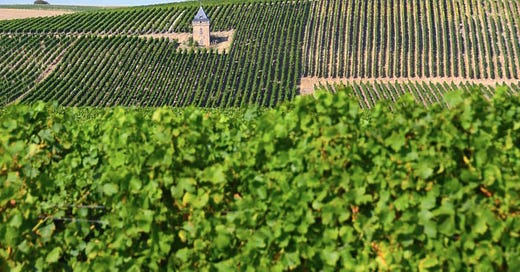



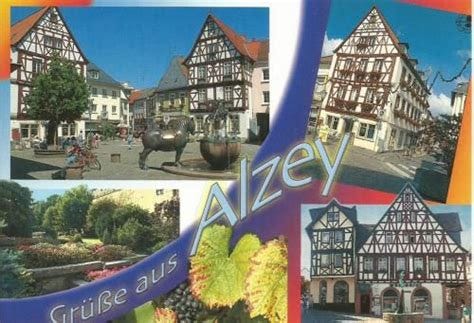
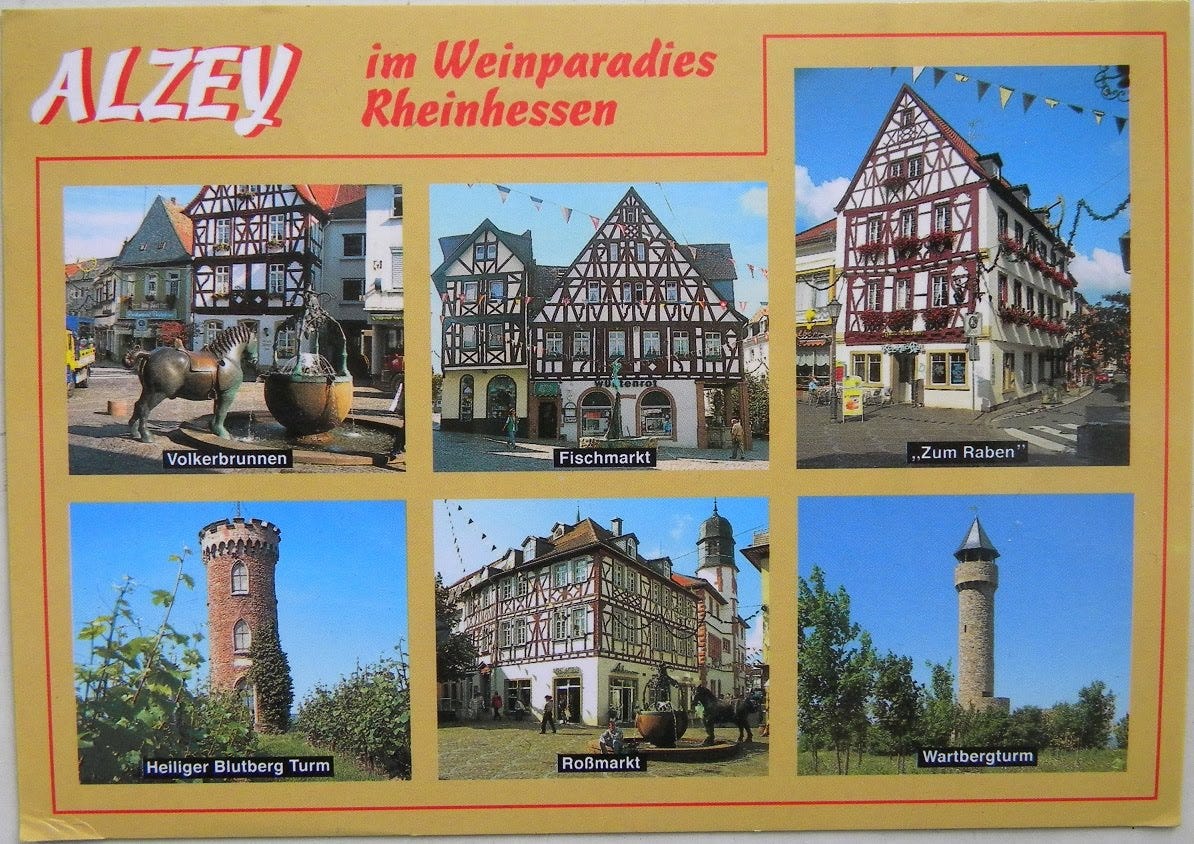
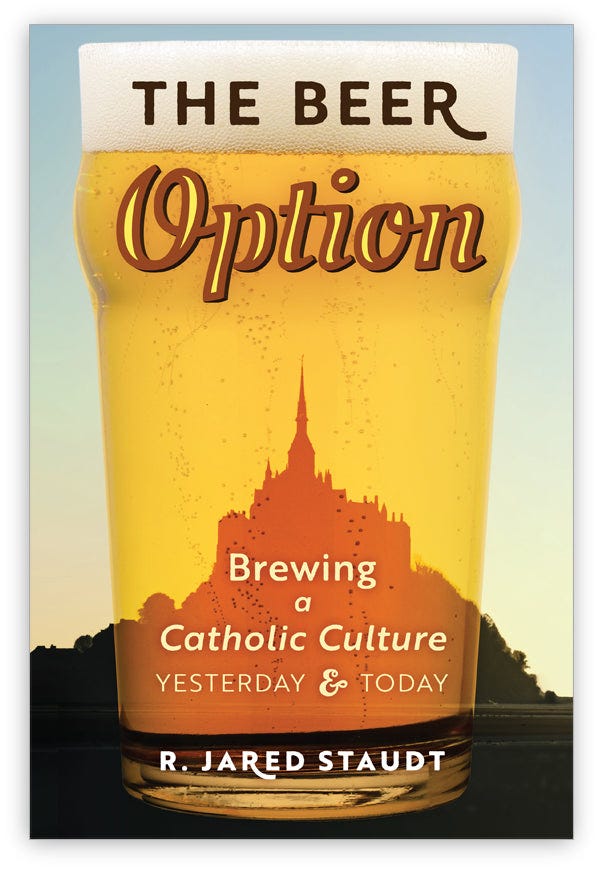

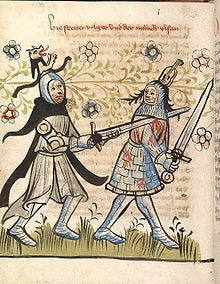

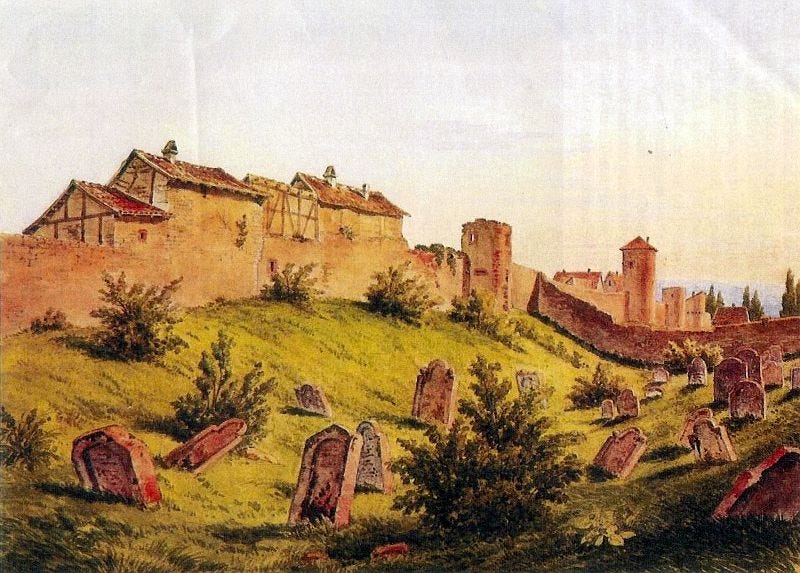
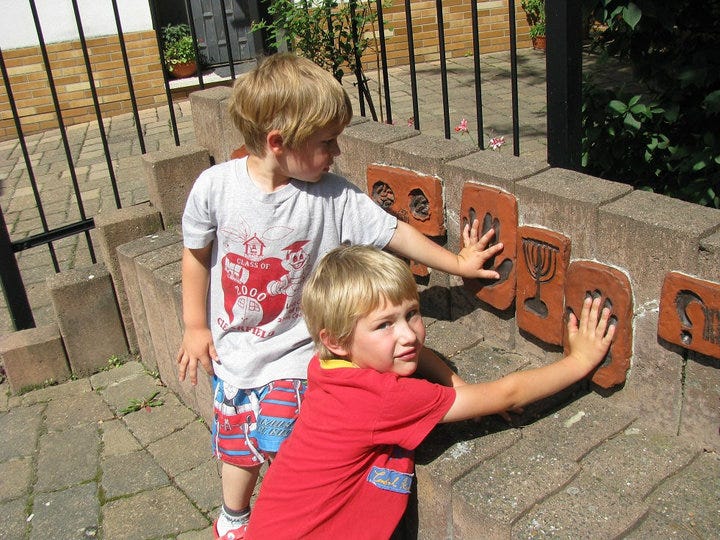
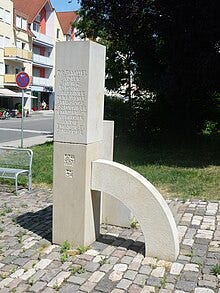

![ger3_00072.jpg [38 KB] - Alzey. Jews are forced to clean election propaganda, May 1933 ger3_00072.jpg [38 KB] - Alzey. Jews are forced to clean election propaganda, May 1933](https://substackcdn.com/image/fetch/$s_!ou8X!,w_1456,c_limit,f_auto,q_auto:good,fl_progressive:steep/https%3A%2F%2Fsubstack-post-media.s3.amazonaws.com%2Fpublic%2Fimages%2Fe8f95eb5-1bd3-4fd7-b232-be9038d04623_450x254.jpeg)
